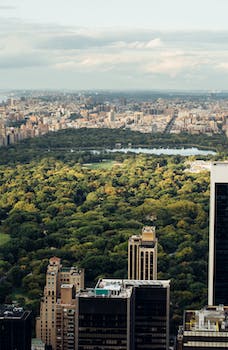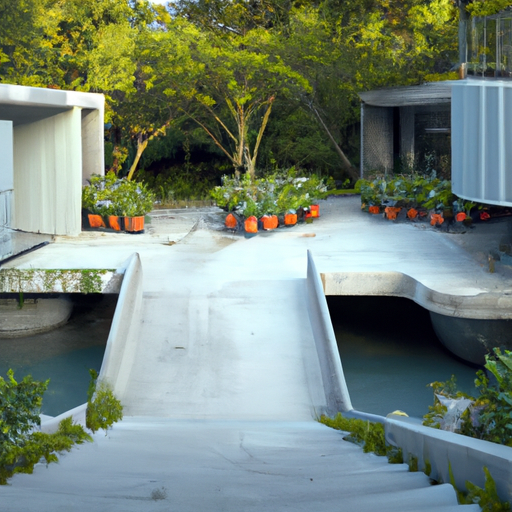Integrating Green Spaces and Sustainable Design in Modern Complexes
Creating a modern complex that blends with its natural surroundings is an architectural challenge that requires a delicate balance between aesthetics, functionality, and sustainability. As urbanization continues to expand, the need for integrating green spaces and sustainable design in modern complexes becomes increasingly important. This not only enhances the quality of life for residents and visitors but also contributes to the overall well-being of the environment.
One of the key aspects of integrating green spaces in modern complexes is the incorporation of vegetation and natural elements into the design. This can be achieved through various methods, such as green roofs, vertical gardens, and landscaped courtyards. Green roofs, for instance, not only provide insulation and reduce energy consumption but also create a habitat for birds and insects, promoting biodiversity. Vertical gardens, on the other hand, can help purify the air and reduce noise pollution, while landscaped courtyards offer a serene space for relaxation and social interaction.
In addition to incorporating green spaces, sustainable design principles should also be applied to the overall layout and construction of the complex. This includes optimizing the orientation and shape of the buildings to maximize natural light and ventilation, as well as selecting energy-efficient materials and systems. For example, using high-performance glazing can help reduce heat gain and loss, while incorporating renewable energy sources, such as solar panels or wind turbines, can contribute to a lower carbon footprint.
Water management is another crucial aspect of sustainable design in modern complexes. This involves implementing strategies to reduce water consumption, such as low-flow fixtures and rainwater harvesting systems, as well as treating and reusing wastewater for irrigation and other non-potable uses. Moreover, incorporating permeable surfaces and green infrastructure, such as bioswales and rain gardens, can help manage stormwater runoff and prevent flooding.
In order to create a modern complex that truly blends with its natural surroundings, it is essential to consider the local ecosystem and its unique characteristics. This means preserving existing vegetation and wildlife habitats, as well as incorporating native plant species in the landscaping. By doing so, the complex can contribute to the conservation of local biodiversity and provide a sense of place that connects residents and visitors to the natural environment.
Furthermore, fostering a sense of community and promoting social interaction is an important aspect of integrating green spaces and sustainable design in modern complexes. This can be achieved by providing a variety of public spaces, such as parks, plazas, and community gardens, that cater to different age groups and interests. Additionally, incorporating amenities, such as cafes, shops, and cultural facilities, can help create a vibrant and dynamic environment that encourages people to spend time outdoors and engage with their surroundings.
In conclusion, creating a modern complex that blends with its natural surroundings requires a holistic approach that combines green spaces, sustainable design principles, and a strong connection to the local ecosystem. By doing so, architects and developers can not only enhance the quality of life for residents and visitors but also contribute to the overall well-being of the environment. As urbanization continues to grow, it is crucial that we prioritize the integration of green spaces and sustainable design in modern complexes to ensure a harmonious coexistence between the built environment and the natural world.
Harnessing Natural Elements for Energy Efficiency in Contemporary Architecture

Creating a modern complex that blends with its natural surroundings is an architectural challenge that requires a delicate balance between aesthetics, functionality, and sustainability. As the world becomes increasingly aware of the need to reduce our carbon footprint and preserve the environment, architects and designers are turning to innovative solutions that harness natural elements for energy efficiency in contemporary architecture. By incorporating these elements into the design of a building, it is possible to create a structure that not only complements its surroundings but also contributes to a more sustainable future.
One of the most effective ways to harness natural elements for energy efficiency is through the use of passive solar design. This approach involves the strategic placement of windows, walls, and floors to collect, store, and distribute solar energy in the form of heat during the winter months, while also rejecting solar heat during the summer months. By taking advantage of the sun’s natural energy, passive solar design can significantly reduce the need for artificial heating and cooling systems, resulting in lower energy consumption and reduced greenhouse gas emissions.
Another important aspect of creating a modern complex that blends with its natural surroundings is the use of natural materials. By incorporating materials such as wood, stone, and clay, architects can create structures that not only have a lower environmental impact but also blend seamlessly with the surrounding landscape. These materials are often locally sourced, reducing the carbon footprint associated with transportation and supporting local economies. Additionally, natural materials often have inherent thermal properties that can contribute to a building’s overall energy efficiency.
Green roofs and living walls are another innovative way to harness natural elements for energy efficiency in contemporary architecture. These features involve the integration of vegetation into the building’s design, either on the roof or exterior walls. Green roofs and living walls provide numerous benefits, including improved insulation, reduced heat island effect, and stormwater management. They also contribute to the building’s overall aesthetic appeal, creating a visually pleasing environment that blends with its natural surroundings.
In addition to these design features, architects are also exploring the use of renewable energy sources to further enhance the sustainability of modern complexes. Solar panels, wind turbines, and geothermal systems are just a few examples of renewable energy technologies that can be incorporated into a building’s design. By generating clean, renewable energy on-site, these systems can significantly reduce a building’s reliance on fossil fuels and contribute to a more sustainable future.
Water conservation is another crucial aspect of creating a modern complex that blends with its natural surroundings. By incorporating features such as rainwater harvesting systems, greywater recycling, and low-flow fixtures, architects can design buildings that use water more efficiently and reduce the strain on local water resources. These systems not only contribute to a building’s overall sustainability but also help to maintain the delicate balance of the surrounding ecosystem.
In conclusion, harnessing natural elements for energy efficiency in contemporary architecture is an essential component of creating a modern complex that blends with its natural surroundings. By incorporating passive solar design, natural materials, green roofs, living walls, renewable energy sources, and water conservation measures, architects can create structures that not only complement the environment but also contribute to a more sustainable future. As the world continues to grapple with the challenges of climate change and resource depletion, it is more important than ever for architects and designers to embrace these innovative solutions and create buildings that are both beautiful and environmentally responsible.
Balancing Aesthetics and Functionality in Eco-Friendly Complex Developments
Creating a modern complex that blends with its natural surroundings is an architectural challenge that requires a delicate balance between aesthetics and functionality. As the world becomes increasingly aware of the importance of sustainable living and eco-friendly practices, architects and developers are tasked with designing buildings and complexes that not only meet the needs of their occupants but also minimize their impact on the environment. This involves incorporating green technologies, using sustainable materials, and ensuring that the complex harmoniously coexists with its surroundings.
One of the key aspects of creating a modern complex that blends with its natural surroundings is the integration of green spaces. This can be achieved through the inclusion of rooftop gardens, vertical gardens, and landscaped courtyards. These green spaces not only provide a visual connection to nature but also offer numerous environmental benefits, such as improved air quality, reduced urban heat island effect, and increased biodiversity. Additionally, green spaces can contribute to the overall well-being of the occupants by providing areas for relaxation, socialization, and physical activity.
Another important consideration in designing an eco-friendly complex is the use of sustainable materials. This involves selecting materials that have a low environmental impact, such as recycled or reclaimed materials, as well as those that are sourced locally to reduce transportation emissions. Furthermore, the use of materials with low embodied energy, such as timber and bamboo, can significantly reduce the carbon footprint of the complex. In addition to being environmentally friendly, these materials can also contribute to the aesthetic appeal of the complex by providing a natural and organic look.
The incorporation of green technologies is also essential in creating a modern complex that blends with its natural surroundings. This can include the use of solar panels, wind turbines, and geothermal systems to generate clean and renewable energy for the complex. Additionally, energy-efficient lighting, heating, and cooling systems can be installed to reduce energy consumption and minimize the complex’s impact on the environment. Water conservation measures, such as rainwater harvesting and greywater recycling systems, can also be implemented to reduce water usage and promote sustainable water management practices.
In order to create a harmonious relationship between the complex and its surroundings, it is crucial to consider the site’s natural features and landscape. This can involve preserving existing trees and vegetation, as well as incorporating native plants and wildlife habitats into the design. By doing so, the complex can seamlessly blend with its surroundings and contribute to the overall ecological health of the area. Additionally, the use of natural materials and earth-toned colors can further enhance the visual connection between the complex and its environment.
Lastly, it is important to consider the needs and preferences of the occupants when designing a modern complex that blends with its natural surroundings. This can involve creating flexible and adaptable spaces that cater to various lifestyles and preferences, as well as incorporating amenities that promote health and well-being, such as fitness centers, communal gardens, and walking paths. By prioritizing the needs of the occupants, architects and developers can create a complex that not only blends with its surroundings but also fosters a sense of community and belonging among its residents.
In conclusion, creating a modern complex that blends with its natural surroundings requires a careful balance between aesthetics and functionality. By incorporating green spaces, sustainable materials, and green technologies, as well as considering the site’s natural features and the needs of the occupants, architects and developers can create eco-friendly complexes that not only minimize their impact on the environment but also provide a visually appealing and comfortable living space for their residents. As the world continues to grapple with the challenges of climate change and environmental degradation, the importance of designing sustainable and harmonious complexes cannot be overstated.
Q&A
Question 1: What are the key design principles for creating a modern complex that blends with its natural surroundings?
Answer 1: The key design principles include incorporating sustainable materials, maximizing natural light, integrating green spaces, using organic forms and shapes, and prioritizing energy efficiency and water conservation.
Question 2: How can architects ensure that a modern complex has minimal impact on the local ecosystem?
Answer 2: Architects can ensure minimal impact by conducting thorough site analysis, preserving existing vegetation, implementing stormwater management systems, using permeable surfaces, and incorporating native plants in landscaping.
Question 3: What are some examples of modern complexes that successfully blend with their natural surroundings?
Answer 3: Examples include the California Academy of Sciences in San Francisco, the Fallingwater House in Pennsylvania, and the Treehotel in Sweden. These complexes showcase innovative design approaches that harmonize with their surrounding environments.
Conclusion
In conclusion, creating a modern complex that blends with its natural surroundings is an innovative approach to architecture and urban planning. This design philosophy prioritizes sustainability, environmental conservation, and the well-being of inhabitants. By integrating natural elements and using eco-friendly materials, such complexes can minimize their ecological footprint, enhance the aesthetic appeal, and promote a harmonious coexistence between human-made structures and the natural environment.


